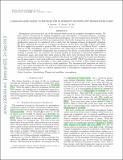| dc.contributor.author | Seager, Sara | |
| dc.contributor.author | Bains, William | |
| dc.contributor.author | Hu, Rui | |
| dc.date.accessioned | 2014-03-10T21:16:15Z | |
| dc.date.available | 2014-03-10T21:16:15Z | |
| dc.date.issued | 2013-09 | |
| dc.date.submitted | 2012-10 | |
| dc.identifier.issn | 0004-637X | |
| dc.identifier.issn | 1538-4357 | |
| dc.identifier.uri | http://hdl.handle.net/1721.1/85605 | |
| dc.description | Author Manuscript September 24, 2013 | en_US |
| dc.description.abstract | Biosignature gas detection is one of the ultimate future goals for exoplanet atmosphere studies. We have created a framework for linking biosignature gas detectability to biomass estimates, including atmospheric photochemistry and biological thermodynamics. The new framework is intended to liberate predictive atmosphere models from requiring fixed, Earth-like biosignature gas source fluxes. New biosignature gases can be considered with a check that the biomass estimate is physically plausible. We have validated the models on terrestrial production of NO, H[subscript 2]S, CH[subscript 4], CH[subscript 3]Cl, and DMS. We have applied the models to propose NH[subscript 3] as a biosignature gas on a "cold Haber World," a planet with a N[subscript 2]-H[subscript 2] atmosphere, and to demonstrate why gases such as CH[subscript 3]Cl must have too large of a biomass to be a plausible biosignature gas on planets with Earth or early-Earth-like atmospheres orbiting a Sun-like star. To construct the biomass models, we developed a functional classification of biosignature gases, and found that gases (such as CH[subscript 4], H[subscript 2]S, and N[subscript 2]O) produced from life that extracts energy from chemical potential energy gradients will always have false positives because geochemistry has the same gases to work with as life does, and gases (such as DMS and CH[subscript 3]Cl) produced for secondary metabolic reasons are far less likely to have false positives but because of their highly specialized origin are more likely to be produced in small quantities. The biomass model estimates are valid to one or two orders of magnitude; the goal is an independent approach to testing whether a biosignature gas is plausible rather than a precise quantification of atmospheric biosignature gases and their corresponding biomasses. | en_US |
| dc.description.sponsorship | Foundational Questions Institute (FQXi) | en_US |
| dc.language.iso | en_US | |
| dc.publisher | IOP Publishing | en_US |
| dc.relation.isversionof | http://dx.doi.org/10.1088/0004-637x/775/2/104 | en_US |
| dc.rights | Creative Commons Attribution-Noncommercial-Share Alike | en_US |
| dc.rights.uri | http://creativecommons.org/licenses/by-nc-sa/4.0/ | en_US |
| dc.source | arXiv | en_US |
| dc.title | A BIOMASS-BASED MODEL TO ESTIMATE THE PLAUSIBILITY OF EXOPLANET BIOSIGNATURE GASES | en_US |
| dc.type | Article | en_US |
| dc.identifier.citation | Seager, S., W. Bains, and R. Hu. “A BIOMASS-BASED MODEL TO ESTIMATE THE PLAUSIBILITY OF EXOPLANET BIOSIGNATURE GASES.” The Astrophysical Journal 775, no. 2 (October 1, 2013): 104. | en_US |
| dc.contributor.department | Massachusetts Institute of Technology. Department of Earth, Atmospheric, and Planetary Sciences | en_US |
| dc.contributor.department | Massachusetts Institute of Technology. Department of Physics | en_US |
| dc.contributor.mitauthor | Seager, Sara | en_US |
| dc.contributor.mitauthor | Bains, William | en_US |
| dc.contributor.mitauthor | Hu, Rui | en_US |
| dc.relation.journal | The Astrophysical Journal | en_US |
| dc.eprint.version | Author's final manuscript | en_US |
| dc.type.uri | http://purl.org/eprint/type/JournalArticle | en_US |
| eprint.status | http://purl.org/eprint/status/PeerReviewed | en_US |
| dspace.orderedauthors | Seager, S.; Bains, W.; Hu, R. | en_US |
| dc.identifier.orcid | https://orcid.org/0000-0002-6892-6948 | |
| mit.license | OPEN_ACCESS_POLICY | en_US |
| mit.metadata.status | Complete | |
